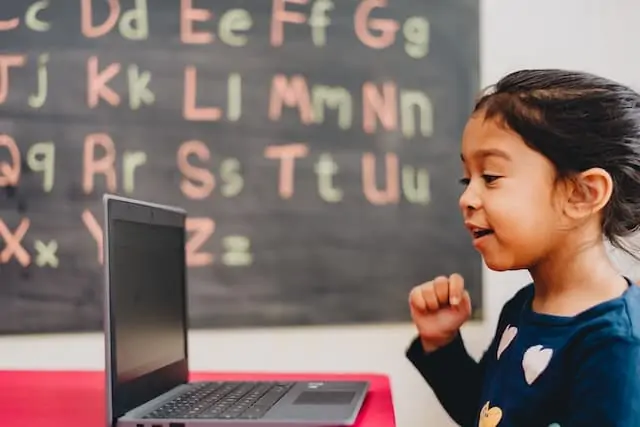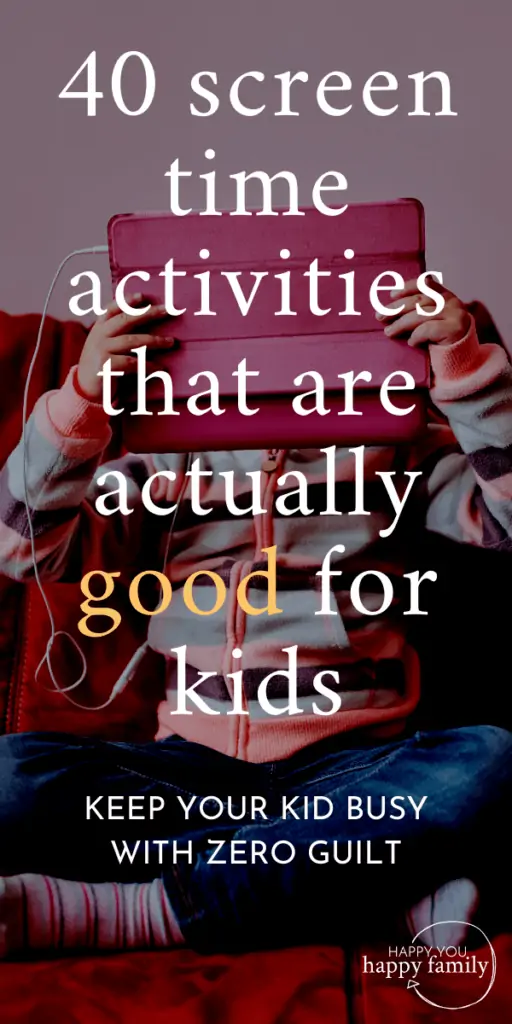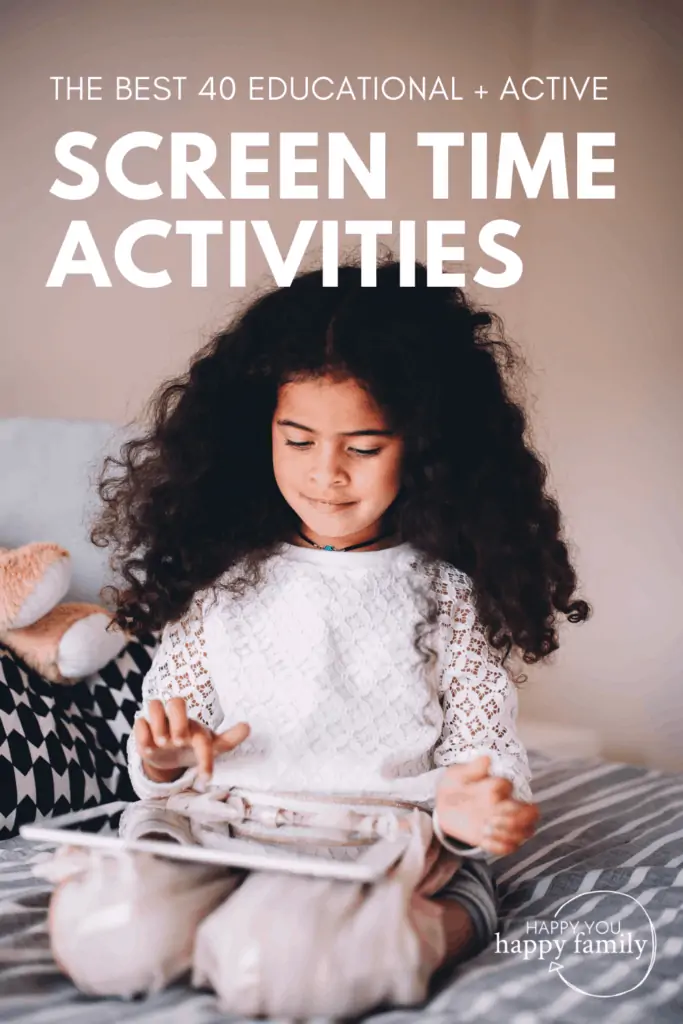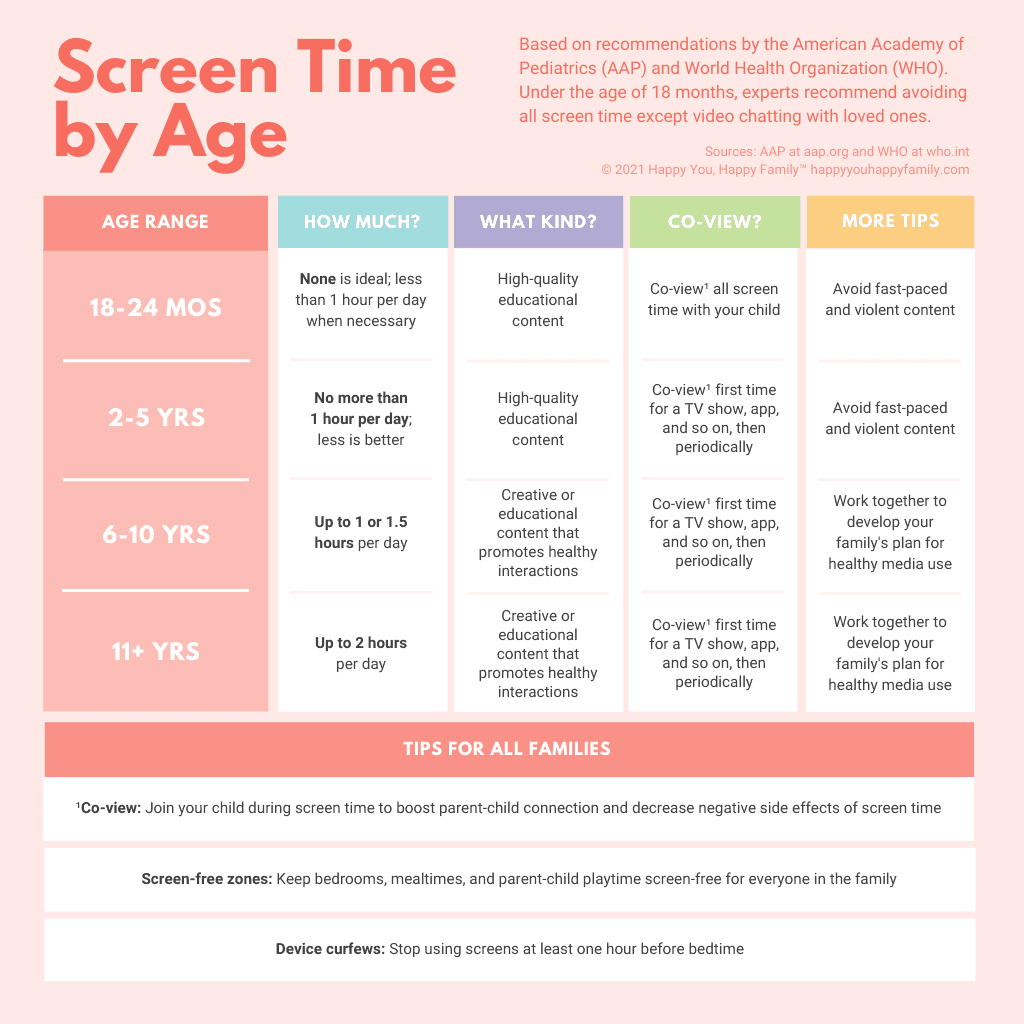When You Can’t Avoid Screen Time: 40 Activities That Are Actually Good for Kids
I have zero qualms about sticking my kids in front of an iPad or a movie when I need to.
Screen time can be a lifesaver when I’m working from home, need to make an important phone call, or just want to take a shower without kids barging in to complain about the latest sibling infraction every two minutes.
But when I first started relying on screen time with my oldest several years ago, I noticed a disturbing phenomenon.
After she was done with the screens and rejoined real life, she’d turned into a zombie. A cranky zombie.
With everything from whining to full-on meltdowns, the “screen time zombie effect” was no joke. Later on, I discovered that I wasn’t alone. Depending on the child, screen time can make kids quick to anger, highly irritable, or moody and unmotivated.
But That Wasn’t the Worst Part
Even after playing “educational” apps for kids, my daughter couldn’t answer the most basic of math problems. It’s like her brain had stopped working.
As it turns out, this isn’t uncommon. Research shows that screen time can decrease a child’s score on language and cognitive tests.
Given these effects, no wonder both the World Health Organization and the American Academy of Pediatrics recommend limiting daily screen time for kids.

Here’s the Good News
All screen time is not created equal. Certain types of screen time activities can cause all those negative effects, but other types of screen time can inoculate your child against a zombie outbreak.
“The quality of what children watch on screens is more important than how much they watch.”
Susan Friedman, National Association for the Education of Young Children
For example, research shows that fast-moving animation or video leads to attention issues in children. On the other hand, educational and slower-paced screen time doesn’t have the same negative effects.
In other words, a child who plays Fortnite for an hour straight will come off screens a lot crankier than a child who watches a one-hour nature documentary.
Bonus: As a bonus for joining my weekly newsletter, get a free cheat sheet of how much and what kind of screen time is recommended for your child’s age and developmental stage, according to health experts.
40 Screen Time Activities That Are Actually Good for Your Child
Screen time has become a necessity for many parents in today’s world, myself included. When we have work to do or households to run (or both), we can’t always oversee our kids’ every waking moment 12+ hours a day. And yet, sticking the kids on screen time several hours a day isn’t the best option either because it can interfere with our kids getting enough sleep, a healthy amount of physical activity, and the kinds of experiences they need in order to thrive.
But we can use screen time in moderation when it’s the right kind of screen time. The kind that won’t turn our kids into zombies. The kind we don’t have to feel guilty about because not only does it avoid the negative effects of screen time, our kids will actually learn something too.
Below, you’ll find a list of the best screen time activities for kids so that you can get what you need to done – no matter if that means working from home with kids or just sneaking away to raid your secret chocolate stash so that you feel recharged and ready to deal with whatever parenting life throws at you next.
But First, a Bonus Tip for You!
One of the dangers of screen time for kids is that when kids spend time on screens, that leaves less time for activities that will improve their wellbeing and increase happiness, like daily physical activity or time spent outdoors.
In our family, we came up with a simple way to make sure our kids get the essential ingredients they need everyday to protect their wellbeing: 4 quick questions to ask your child every day. It takes just a few minutes, you can do it at the dinner table, and it helps removes the burden from you when it comes to policing screen time activities.
After you take a swing through the list of screen time activities below, check out those special questions here.
Educational Screen Time
To be clear, kids learn more from face-to-face interaction than they do from screens. But when you can’t engage with your child face-to-face every waking hour of the day, the right kind of screen time can be educational. Research shows that starting at age three, kids can learn from slower-paced, thoughtful screen time activities, boosting everything from their academic performance to their social-emotional skills.
- Watch a kid-friendly documentary. Here are a few excellent documentaries my kids have enjoyed, and they all come highly recommended by the experts at Common Sense Media:
- The Biggest Little Farm – available to rent on Amazon here
- Chasing Coral – available on Netflix here
- The Elephant Queen – available on Apple TV+
- March of the Penguins – available to rent on Amazon here
- My Octopus Teacher – available on Netflix here
- A Reindeer’s Journey – available to rent on Amazon here
- Spellbound – available to rent on Amazon here
- Walking with Dinosaurs – available to rent on Amazon here
- Several documentaries from Disneynature have activity packets you can download as a supplement to the documentary
- Go on a virtual safari. If your child loves animals, set them up with a few different live webcams from zoos and aquariums so they can try to find the animals and see what they’re up to. Here are a few of our favorites:
- Beluga whales, penguins, puffins, otters, sea lions, piranhas, and alligators at the Georgia Aquarium
- Lions, elephants, pandas, and naked mole rats at the Smithsonian’s National Zoo
- Giraffes, gorillas, elephants, rhinos, and chimps at the Houston Zoo (you can even control the camera to zoom in and pan around)
- Polar bears, koalas, tigers, baboons, penguins, giraffes, elephants, and more at the San Diego Zoo
- Goats and sheep at the Folly Farm in the United Kingdom (the kids love when they have new babies on the live feed!)
- African animals in the wild in Kenya
- Puppies training to be service dogs
- Try Mister Rogers. If your child hasn’t seen the show before, I recommend watching a Mister Rogers episode together the first time, or you can play LEGOs or make art together while the episode plays in the background. Then pay attention to your child. This slow-paced children’s show tends to put many kids in a sort of calm trance, and when the episode is over, they aren’t moody like they tend to be after other kinds of television. Guilt-free screen time? Check!
- Let them pick a class. At Outschool, your child can browse the online classes available and pick what they want to learn about, from ASL to raising chickens to video game design – pretty much everything you can think of! Classes are small groups of students who meet via video chat regularly, and teachers are experts on the topic they’re teaching about. For older kids and teens, you can also check MasterClass to see if they have a class with an expert that might be a good fit. For example, they can get tennis lessons from Serena Williams or learn about songwriting from John Legend. If you don’t find a class there, another great option for older kids and teens is Skillshare.
- Queue up a playlist. What is your kid obsessed with? Some kids are obsessed with dinosaurs, others might be obsessed with construction vehicles. One of my kids is all-in on Harry Potter, while another is obsessed with dolphins. Scientists call this an “intense interest,” and research shows that encouraging your child’s intense interest makes them better learners and makes them smarter. To support your child’s intense interest, spend a few minutes searching for educational videos on Youtube on that topic and make them a playlist of videos to watch. Kids who have an intense interest will enjoy a video playlist like this many times over, soaking up more knowledge every time through!
- Do a science experiment. Bookmark a couple Youtube channels with kids’ science experiments so your child can browse around and find an experiment to try at home. Our favorite Youtube channels for this are The Spangler Effect and LAB 360. (By the way, we also have this book of 10-minute science experiments for kids, and my kids love it!)
- Nurture a habitat. Set a family goal to turn your yard into a backyard wildlife habitat and get it certified by the National Wildlife Federation. Set your child loose on the NWF site to learn everything you’ll need to do, then ask them to draft a plan for how to make it happen. This is such a fun project for kids because it also gets them outside, making bird feeders and squirrel feeders, planting native plants, observing wildlife, and learning about the thriving ecosystem right in their own backyard. To keep the fun going even more, get your child a pair of kid-friendly binoculars and a bird watching guide so they can figure out which birds are showing up.
- Watch videos with a purpose. The next time your child begs to watch videos on YouTube, forget the creepy knockoff Peppa Pig videos and load up one of these powerful videos for kids instead. I’ve been curating this special list of short, high-quality videos for kids for several years. Watching the videos on that list will teach your child how to be a kind and thoughtful friend. Your child will get proven tricks for how to handle their big, scary emotions. They’ll learn important life lessons like why we should accept others even if they’re different – and more. As just one example, here’s a short video from that list that helps kids learn how to cope with emotions:
- Learn a second language. Research shows that learning a second language boosts your child’s memory skills, improves their ability to focus, and enhances their reading comprehension and vocabulary in their first language as well. The easiest way to get your child started learning another language is to set them up with a language learning app for kids. Our favorite apps are Drops for younger kids and Duolingo for older kids around 10 and up.
- Find out why. Pay attention to when your child is curious about something and asks “why.” Then encourage them to come up with a hypothesis, research the answer, and make a fun slide show to share their discoveries with the whole family. You can add more structure to this educational screen time activity by setting a certain day of the week for these slide shows, like “Why Wednesdays,” with each person in the family taking turns every week sharing their own discoveries. Another fun way to make this a habit is to start a “curiosity journal” where anyone in the family can jot down anything they’re curious about, then keep it in a central, visible location like your kitchen counter or coffee table. Then when your child is bored, they can flip through the curiosity journal and find something to research.
- Say goodbye to hunt-and-peck. Touch typing is a life skill that will serve your child well throughout their school years and beyond. Set your child up with a touch typing program like the award-winning Keyboarding Without Tears. Three of my kids have learned touch typing through this program, and I highly recommend it.
- Go explore. Exploring the world via Google Earth is fun in its own right, but for a little more structure, you can set your child up with an educational app that’s built with Google Earth, like the Where on Google Earth Is Carmen Sandiego? game or their Flight Simulator. For more ideas, check out these projects on the Google Earth educational hub.
- Do today’s crossword. Older kids can get a new (free!) crossword to solve every day at The Guardian, Los Angeles Times, The New York Times mini crossword, The Washington Post, and Merriam-Webster. For younger kids, the puzzle and crossword maker Lovatts regularly posts news crosswords for kids, and USA Today also has a daily easy crossword. And while this doesn’t count as educational screen time, it’s still awesome: The New York Times has a huge archive of themed crosswords for students that you can print.
- Play a brain food app or game. When it comes to apps and games, some are better than others for staving off the screen time zombie effect. Here’s a list of the best educational apps for kids that won’t make them moody and unruly afterwards.
Creative Screen Time
Creative activities are important for your child’s development, plus engaging in creative activities has also been shown to impact health by reducing stress and anxiety, increasing positive emotions, and reducing the likelihood of depression. Below, you’ll find the best screen time activities to foster your child’s creativity.
For more creative activity ideas, check out The Best Activities for Kids At Home: Creative Fun.
- Compose. At the Chrome Music Lab, kids can make and share their own music. Start them out with the Song Maker experiment and let them explore from there. If your child enjoys that, they can graduate to an app like GarageBand for more features.
- Draw something. If you’re short on art supplies or you’re out and about running errands, your child can use an app like Drawing Pad to get creative. For tweens and teens, Procreate is a high-quality app that will inspire a budding digital artist.
- Design a comic. With the Strip Designer app, kids can design their own comic strip using their own photos. This is a fun and creative way to get kids journaling about their memories and experiences like a favorite family vacation or their first day of school, which is awesome because journaling helps kids cope with emotions, especially negative emotions.
- Make a craft. Queue up a Youtube playlist of a few fun craft projects, then share it with your child so they can decide which one they want to make and then follow the instructions in the video. For example, they could make something like friendship bracelets, a latch hook project, a cross-stitch design, and so on. Anytime they’re bored, they can revisit the playlist and pick a new project to make.
- Design a family yearbook. Kids love flipping through photo books to relive their favorite experiences, but creating a scrapbook can be time-consuming. So hand it off to your kid! My favorite tool for creating photo books is Shutterfly. You just upload your favorite photos, use one of their templates, and you’re good to go.
- Make a movie. Your child can play filmmaker by writing a script, designing a set, pulling together the costumes, and recording the video. For only children, they can create a one-person show, but for multiple kids the whole crew can get in on the project. If your child needs a little more structure to get started, the GoldieBlox and the Movie Machine app teaches kids how to make a stop-motion movie.
- Write a story. At My Storybook, kids can write their own story and illustrate it using pre-drawn characters and pictures or their own drawings. When your child is done creating their story, you can even turn it into a printable book.
- Follow a recipe. Bookmark a few foodie Youtube channels and encourage your child to browse through them and find a recipe that looks good, then follow along in the video to make it. They can try a new recipe for dinner or make a baked good as a family treat. Our favorite channel is Eats Amazing.
Bookish Screen Time
When it comes to boosting your child’s literacy skills, reading aloud is a must for every family. But if you’re already reading aloud at least 15 minutes a day, go ahead and sprinkle in a few slower-paced, thoughtful screen time activities to enrich your child’s literacy.
For more bookish activity ideas, check out The Best Activities for Kids At Home: Bookish Fun.
- Catch up on what’s new. Some news outlets have special editions just for kids and teens to help them understand what’s going on in the world in a kid-friendly way. Our favorites are The Washington Post’s KidsPost, Time for Kids, and the PBS NewsHour Extra edition.
- Watch video adaptations of children’s books. You can purchase these story time videos on Apple TV, or some libraries participate in Kanopy Kids so you can get free access to a whole bucketload of them. After you log into Kanopy and go to the Kanopy Kids section, look for the “Story Time” category. (Side note: You’ll also get access to lots of kid-friendly documentaries through Kanopy!)
- Let a famous actor read aloud to your child. Through Storyline Online, you can access free videos of actors reading children’s books aloud.
- Listen to a children’s book author. Children’s book author Kate Messner put together an amazing resource of videos with authors reading aloud, leading kids through art activities, and more. She’s done the hard work of finding all the awesomeness, so you just need to queue up a few of the videos for your child to watch.
- Create a family newsletter or newspaper. To keep your friends and family updated on what’s new with your family, encourage your child to act like a reporter and design a newspaper-style update of everything that’s going on. They can use a word processing app or a free design tool like Canva and export as a PDF to share. Your loved ones will appreciate the adorable update, and your child will stay busy for a while pulling the whole thing together.
- Be a critic. At Common Sense Media, you can set up an account so that your child can write reviews of their favorite TV shows, movies, books, games, and apps to help other kids decide whether to try them out.
- Start a journal. Journaling is a powerful tool for helping kids cope with emotions because it puts you into a state of mindfulness, where your negative experiences don’t seem quite so earth-shattering. Also, the emotional release you get from journaling can lower anxiety and stress, plus help you sleep better. Our favorite journaling app is Day One because you can set your device to give you a reminder once a day, and it will give you a prompt if you’re not sure what to write about. (If you prefer a paper journal, check out our list of the best journals for kids and pick up one for your child: 10 Best Journals for Kids That Will Boost Your Child’s Emotional Intelligence.)

Social Screen Time
Social screen time activities can be a fun way for your child to stay connected to the people they care about, and that connectedness is a protective factor for a child’s health and wellbeing. Plus, some research shows young kids learn important social skills from the back-and-forth of social interaction on screen time.
- FaceTime or Skype a relative or friend. For example, if your child’s grandparents are retired, set your child up so they can make a video call and chat. The grandparents will be happy, and your child will be entertained. Face-to-face video calls can have positive effects on kids, so the AAP says they’re appropriate even for toddlers!
- Play a game. Use a virtual meeting tool like Zoom to set up a get-together with your friends or family, then play a game like Charades or Pictionary (using the whiteboard feature in Zoom). You don’t even need the physical game to play because the person who’s acting out or drawing just has to come up with an idea of what to act out or draw. As another option, you can visit PlayingCards.io to play a card game with your friends in your browser and use Zoom to chat while you play.
- Make a date. Set up a regular weekly date for your child to meet up with their group of friends (or all their cousins!) in a virtual meeting tool like Zoom. They can play games (see the previous bullet) or just get together to chat. If they struggle to think of things to talk about, you can get this set of the Best Conversation Starters for Kids and have them pick a random question to keep the conversation going. Not only do these conversation starters teach your child the art of a good conversation, but they’ll deepen their connection with their friends by chatting about meaningful (and fun!) topics.

- Take texting to the next level. Use the Marco Polo app to set up a private group chat for your child and their friends or for family members. This app is like if you combined a group text thread, video chat, and a private social media network just for you and your real-life family and friends. It’s safe for kids and an awesome way to stay connected!
- Host a movie night. If you have a Netflix, Disney, Hulu, or HBO subscription, install the Chrome extension Teleparty so your child and their friends can watch a movie together. Teleparty synchronizes the video playback and adds a group chat so kids can talk during the movie. Only people who have an invitation from you can join the party, so you don’t have to worry about strangers getting in. If you don’t have one of those streaming services, Airtime is similar. Don’t forget to pop some popcorn to make your movie night official!
- Sit together. Research shows that when you join your child in their screen time activities and chat about what you’re watching together – known as “co-viewing” – you increase your child’s literacy skills, boost empathy, and even mitigate the negative effects of certain kinds of screen time like violent scenes in movies and TV. You don’t have to co-view every bit of screen time, but if you can pick something once every couple days or so, your child will reap the benefits. To help your child get the most out of the experience, try pointing out interesting details, commenting on similarities between what you’re watching and something in your child’s own life, and pausing the show after a complicated or potentially confusing scene to talk about what just happened.
Active Screen Time
Physical activity is important not just for a child’s physical health but also for their mental health. Screen time activities can be a useful way to keep your child physically active, especially when the weather isn’t the greatest like on rainy days or when you hit triple-digit temperatures.
For more physical activity ideas, check out The Best Activities for Kids At Home: Outdoor Fun.
- Do yoga. For kids ages 3 to 6, we enjoyed this yoga video for kids. For kids ages 7 to 12, this yoga video is a great fit. Then for older kids, we love Jillian Michaels’s Yoga Meltdown. As another option, you can try the Cosmic Kids Yoga Youtube channel.
- Make it a game. Consider getting a video game console that supports exercise games, like the Playstation Move or Nintendo Wii Fit. Depending on the console you choose, your child can play single- and multi-player games like table tennis, dancing, skateboarding, basketball, kickboxing, and more.
- Go on a scavenger hunt. The Pokemon Go app combines screen time with a scavenger hunt in a fun game for kids. Playing Pokemon Go will get your child walking around the neighborhood, chasing and catching their favorite Pokemon. Just be sure to review the safety guidelines from the game maker with your child on a regular basis.
- Make a dance playlist. Look for music videos on Youtube of your child’s favorite upbeat songs, then make them a dance party playlist. You’ll want to screen the videos first just to make sure they’re kid-friendly, but after you make the playlist your child can go straight to that. To make it extra fun, play the playlist on your TV using Chromecast or mirroring your screen with Apple TV. If you need a starting point for songs, check out this playlist of kids’ dance songs that you’ll actually enjoy too. As just one example from that playlist, here’s one great song that will get your kiddo moving:
- Try geocaching. With geocaching, you use a smartphone to find “treasures” hidden in the real world by other geocachers. At the geocaching site or using the app, you look up the coordinates of the hidden caches near you, then set out to find them. When you find a cache, you update the log book (bring a pen!) of everyone who’s visited that cache so far, then if you want you can swap a trinket in the cache for a trinket you brought. For example, you might find coins, toy cards, art supplies like markers or pens, key chains, small books, and so on. The possibilities are endless! Kids get excited when they find a cache, then the next excitement is to discover what’s inside the cache, and the fun keeps going when they get to decide whether they want to swap out a trinket for one they brought instead.
Frequently Asked Questions About Screen Time Activities
Below, you’ll find answers to the most common questions when it comes to minimizing the negative effects of screen time for your child:
- What’s the right amount of screen time for my child’s age?
- What are the negative effects of too much screen time?
- What if my child wants to play a fast-moving app or game that does cause all those negative effects?
- What healthy screen time rules do the experts recommend for families?
What’s the right amount of screen time for my child’s age?
For the most up-to-date guidance from health experts on how much screen time is appropriate for your child’s developmental stage, check out the guidelines from the American Academy of Pediatrics and the World Health Organization.
Here’s a quick chart to show the latest recommendations for each age group, as of 2021. As a bonus for joining my weekly newsletter, get a free printable version of this chart, which includes extra space at the bottom for jotting down any extra agreements your family makes about healthy media use.
What are the negative effects of too much screen time?
Depending on the child, screen time can make kids quick to anger, highly irritable, or moody and unmotivated.
With that said, all screen time activities are not created equal. Certain types of screen time can cause all those negative effects, but other types can be neutral. For example, research shows that fast-moving animation or video can lead to attention issues in children. On the other hand, educational and slower-paced screen time typically doesn’t have the same negative effects.
In other words, a child who plays Fortnite for an hour will likely come off screen time crankier than a child who watches a one-hour documentary.
What if my child wants to play a fast-moving app or game that does cause all those negative effects?
One strategy that can work well is to talk to your child first and work together to come up with a reasonable amount of time to play so that you minimize the negative effects. Then set a timer or an app time limit. For example, on iOS devices, you can use the Screen Time settings to configure a time limit for specific apps.
What healthy screen time rules do the experts recommend for families?
It seems like every time I turn around, a new article comes out with more screen time rules families should be following. To give myself grace as a parent, I prefer to think of this instead as screen time “guardrails” for my family. In other words, what are the basic guidelines that will keep us from getting off track?
Below, you’ll find a few research-backed recommendations from experts that have worked for my family. (Note: For the source where you can find out more about each of these healthy screen time guidelines, click the »» character after the list item.)
- Talk to your child about pros and cons of screen time, and work together to come up with boundaries around their screen time activities (and yours!). According to psychologist and author Jon Lasser, PhD, “It’s important for kids to develop the capacity to self-regulate, and parents who try to micromanage screen time may inadvertently interfere with that self-regulatory development.” If you’d like ideas for this, check out the Media Use Plan wizard from the American Academy of Pediatrics. »»
- Make time in your schedule to co-view media with your child. Research shows that when you join your child in screen time activities and chat about what you’re watching together – known as “co-viewing” – you increase your child’s literacy skills, boost empathy, and mitigate the negative effects of certain kinds of screen time like violent scenes in movies and TV. You certainly don’t have to watch every bit of screen time with your child, but if you can pick something once every couple days or so, your child will reap the benefits. While you watch together, try pointing out interesting details, mentioning similarities between what you’re watching and something in your child’s own life, and pausing the show after a complicated or potentially confusing scene so you can talk about what just happened. »»
- Balance screen time activities with other activities. When kids spend time on screens, that leaves less time for activities that actually improve their wellbeing and increase happiness, like daily physical activity or time spent outdoors. In our family, we came up with a simple way to make sure our kids get the essential ingredients they need everyday to protect their wellbeing: 4 questions to ask your child every day. It takes just a few minutes, you can do it at the dinner table, and it helps removes the burden from you when it comes to policing screen time. »»
- Make a pledge to put your devices down at certain times. Research shows that when kids and parents are engaged in conversation, half of all kids and three-quarters of parents feel the other is distracted by a device. For example, you might come up with a family pledge to put devices away during mealtimes. You can also come up with a code word that you and your child can use when you feel like the other person isn’t paying attention to you, and you’d like them to put down their device. That may sound silly, but having a goofy code word like “bananarama” for shorthand removes the awkwardness of calling someone out for not giving you their full attention! »»
- Set a screen time cutoff before bedtime and put devices to “sleep” in a neutral location. Screen time can be particularly disruptive to a child’s bedtime and lead to them not getting a healthy amount of sleep to support their development. To avoid this, come up with a cutoff time for all screen use, such as an hour before bedtime. To avoid the temptation for your child to stay up late texting friends or playing games, establish a spot in your home outside your child’s bedroom (and yours!) where everyone’s devices charge overnight. »»
Get Your Free Cheat Sheet
Grab the cheat sheet shown above as a reminder of the latest guidance from health experts on how much screen time is appropriate for your child’s age, as of 2021.
- Get the free cheat sheet. Join my weekly-ish newsletter and as a bonus, you’ll get the printable! Just click here to get it and subscribe.
- Print. Any paper will do the trick, but card stock would be ideal.
- Brainstorm a media use plan for your family. Talk to your child about the pros and cons of screen time, and work together to brainstorm healthy boundaries around screen time activities for everyone in the family. If you come up with any additional guidelines for your family, jot them down in the extra space at the bottom of the printable.
- Hang your cheat sheet somewhere handy like the fridge where everyone can see it.
Before you go, get my FREE cheat sheet: 75 Positive Phrases Every Child Needs to Hear
Your Turn
What are your favorite screen time activities for kids? Share in a comment below!






This is so interesting thankyou. My 3yo gets maybe 30 minutes a day of TV when I’m preparing dinner. We’ve noticed recently with one particular (very innocuous and family focussed) cartoon he does get very cranky when it finishes. So now he just gets to watch Playschool, an educational program that has been on Australian tv for probably 50 years. It’s great to have our observations validated. Thanks again.
I love this. We moved from an hour of screentime a day to only an hour a day on week ends. This helped a ton and now my kids play much better. My mom did this for us growing up and I learned to love it even when I HATED it at first.
But we are homeschooling and I can definitely get behind some of these screen activities on week days when I’m at my wits end!